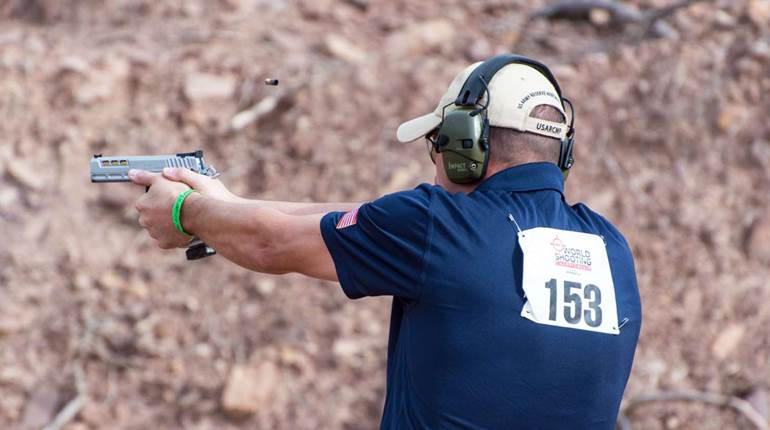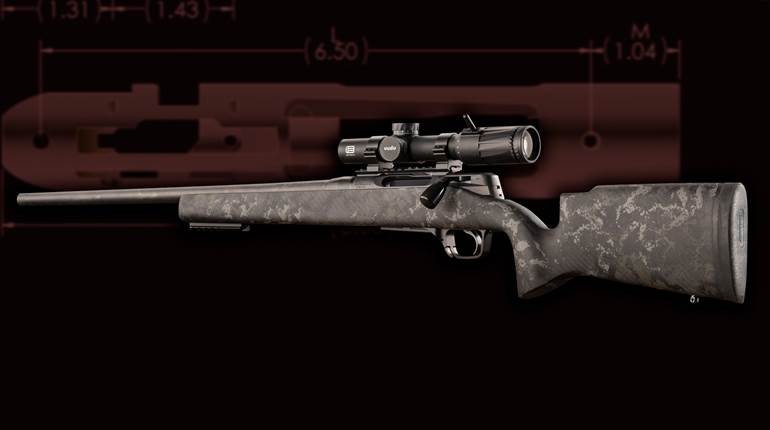
This article was originally published in the November 2007 issue of American Rifleman.
Dangerous-game rifles are different than conventional hunting rifles; by dangerous game I mean animals that can be exceptionally dangerous to the hunter, especially when a first shot is poorly placed. I'm not talking about those without sense who douse themselves in doe estrus during the peak of rut for giggles on YouTube.com, but rather those who pursue the big North American bears and Africa's "Big Five:" elephant, lion, leopard, rhino and Cape buffalo. There are two schools of thought as to what is the best action type to employ on such beasts, either the double rifle or the bolt-action magazine rifle. For the hunter, or client, as African professional hunters call them, a magazine rifle in a manageable caliber with a low-powered optic and having back-up iron sights is usually the ideal tool for the job. Unlike your favorite deer rifle, you may have to bet your life on such a gun.
It must point naturally and shoulder quickly‚ like a fine English shotgun‚ be utterly reliable and be of sufficient chambering to stop one of the dangerous creatures with a single, well-placed shot. Generally, exceptional accuracy is a secondary concern with such guns. The term "minute of buffalo" gets bandied about, but three shots in 6" offhand quickly at 50 yds. is considered by many in the know as adequate. Ranges are typically short‚ from arm's length to 100 yds.‚ so minute-of-angle groups take a back seat to quick handling and absolute reliability. That said, the Kimber Model 8400 Caprivi delivers on the promise of a proper magazine rifle for dangerous-game hunting, as well providing the tightest groups of any .375 H&H Mag. production rifle with factory ammunition tested in these pages.
Caprivi, by the way is the narrow strip of land in Northeastern Namibia that linked what was formerly German South West Africa to the Zambezi River and Germany's former colony on the East African coast, Tanganyika. Named for German diplomat Leo von Caprivi who negotiated a deal with the British for the strip of land in 1890, the Caprivizipfel in German, remains one of the wildest parts of Africa, chock full of game, including those of the dangerous variety.
When I wrote up the Kimber Model 8400 long-action (May 2006, p. 50), I noted, "the ejection port measures 3.51", which is just about right for the 3.600"-long .375 H&H Magnum." The 8400 Caprivi accepts certain magnum cartridges without requiring a new "magnum-length" action, and it is built on that same 1.365"-diameter, cylindrical 4340 steel receiver. The ejection port is still 3.51" long, so complete .375 cartridges must be just slightly angled for insertion into the magazine; obviously ejection and extraction of fired cases are not an issue.
The heart of the Caprivi is its dual-opposed locking lug bolt, which borrows from both the Model 98 Mauser and the Arisaka, and it has a bolt body 0.68" in diameter, which is polished and left in the white. The lugs are tapered and measure 0.428" high and are 0.422" wide. There are two gas-relief holes in its underside, and there's one on the receiver's right as well. The claw extractor is on the bolt's right and is 4.84" in length; its front face is 0.436" high, and its face measures 0.288" across at its widest point. The claw's engagement surface is generously beveled to allow it to grasp a cartridge on the follower as described below.
The root of the bolt handle serves as a third locking lug, and its rounded knob is 0.80" in diameter. The unknurled knob is an excellent balance of functional size and shape while still being aesthetically pleasing. On the receiver's rear left is the bolt stop; depressing it allows bolt removal to the rear. There is a three-position wing safety on the bolt shroud's right.
Tapering in diameter from 1.25" at the receiver to 0.70" at the muzzle, the 24"-long barrel has a magnum contour with the front sling swivel mounted ahead of the fore-end on a steel barrel band. The button rifling is six-groove with a right-hand twist of one turn in 24". A dished crown protects its origin. Kimber states the chamber is "match grade," and the accuracy results with this story confirm it. Although tighter than standard, there were no problems in feeding factory loads from Federal, Hornady or Winchester in bullet weights from 250 to 300 grs., solid, softpoint or roundnose. Other accuracy-enhancing features are a free-floated barrel, well-executed bedding for the receiver's entire length and aluminum pillars for the two stock screws.
Kimber sought input from experienced writers, riflemakers and hunters in finalizing the Caprivi's design‚ in addition to the experienced hunters and engineers on its staff, including Outdoor Life's Jim Carmichael, "Tracks Across Africa" host Craig Boddington, John Rigby's Geoff Miller, NRA Editorial Director John Zent (my boss) and myself. Kimber asked us about the features the gun should have, what kind and grade of sights, and what the stock dimensions should look like.
Kimber was on the right track anyway, but listened to constructive ideas, and the result is a stock with excellent lines and ergonomics. They are a blend of vintage English Mauser 98-based magazine rifles at the butt with a fore-end taken from classic American guns. The comb is fairly straight, and it is well suited to both iron sights and a low-mounted riflescope. There is a graceful pancake-style cheekpiece on the right side, and its pistol grip has an open radius. The wrist measures just under 5" in diameter at its narrowest point, and it provides excellent control, which contributed to the gun's fast handling qualities. If your knuckles rap the rear of the trigger guard on this gun under recoil, you've done something dramatically wrong.
Stepping up to .375 required two reinforcing throughbolts installed transversely to strengthen the stock. There is an ebony tip on the rounded fore-end, and an ebony line spacer between the buttstock and the classic-looking orange rubber recoil pad. At its widest point, the 1" thick Pachmayr XL Decelerator is 1.98" across and 5.54" high, giving it plenty of surface area to spread out the .375's recoil.
The fore-end has a bit of shadbelly that doesn't spoil the lines, but is deep enough to accommodate four rounds in the magazine. The floorplate is hinged at the front and is opened by pressing forward on its release in the front face of the trigger guard. A fifth round can be inserted on top of the follower and, if the top cartridge in the loaded magazine is depressed, the bolt can ride forward over those in the magazine. Depressing the rear of the extractor behind the bolt lug moves the claw outward slightly as the bolt is closed, allowing a fifth round to chamber.
The rear sight is a New England Custom Gun Service, Ltd., Classic Express Sight with three leaves that are windage-adjustable. The first is a standing V-notch regulated for 50 yds., and two folding leaves can be cut for longer distances, but I did not do so on the sample. The front is a NECGS' Universal screw-on, unbanded, ramped sight that can be fitted with different posts or beads. A hooded white bead is standard.
The initial chambering is .375 H&H, although the .458 Lott will follow as soon as production allows. Remember, guns chambered for the 3.600"-long Lott can also accept 3.340"-long .458 Win. Mag. cartridges. Also, as with other Kimber bolt guns, a Montana-style version will be offered with a Kevlar and graphite synthetic stock with a three-round capacity blind magazine. It will also have a barrel band front sling swivel and premier iron sights.
I practiced almost daily with the Caprivi in anticipation of a trip to Eden in Namibia to tackle a genuine "rogue" elephant‚ a younger bull that was causing trouble and ripping up the landscape and farm equipment‚ as well as leopard, kudu and other plains game. Unfortunately, I was unable to make the trip due to a family emergency. Kimber's Dwight Van Brunt, Craig Boddington and Federal's Anthony Acitelli went on without me, taking two elephant, two leopard and a monster waterbuck amongst other game. I still wince when I open the photos on my laptop, but the rifles performed flawlessly.
I had put in all the requisite range time for a dangerous-game hunt, and over the course of a few months fired more than 400 rounds of .375 H&H for accuracy testing and practice from field positions. There wasn't a hitch or flaw in feeding or firing. Recoil, especially with a Leupold VX-7 on top and a full magazine, was manageable enough to be deemed, well, not unpleasant. My friend and colleague, American Hunter Editor-In-Chief Scott Olmsted, is heading to Africa as this is written with the same rifle. Between the two of us in practice, we've fired nearly every round of .375 in inventory, and his results and experience have been on par with mine.
When I went to the range to test mechanical accuracy at 100 yds. from a Caldwell Lead Sled with 50-lbs. of shot on the tray, I brought only 300-gr. loads, not as an attempt to skew the results in Kimber's favor, but because those were the loads I was to use on the hunt. As can be seen in the accompanying table, this particular Caprivi showed a definite preference for 300 grainers. The 300-gr. Trophy Bonded Sledgehammer, which I was to use on the elephant, turned in some of the tightest groups I've ever fired with a medium-bore rifle. With 250- to 270-gr. loads, accuracy opened up to 1" to 2" range, which is still remarkable. The sample rifle can deliver, with remarkable precision, that ever so critical first shot.
I have high expectations for Kimber bolt-actions. Each seems to be better than the last, and the Caprivi exceeded my expectations. It is a beautifully rendered, distinctly American, dangerous-game rifle‚ although you could hunt any big game with it‚ with all the features and qualities expected but with accuracy that should satisfy even the most demanding rifleman.






































